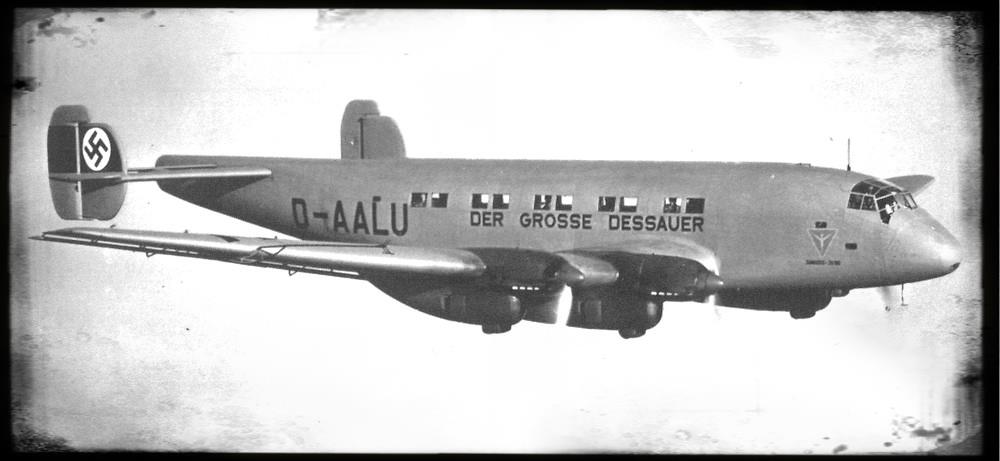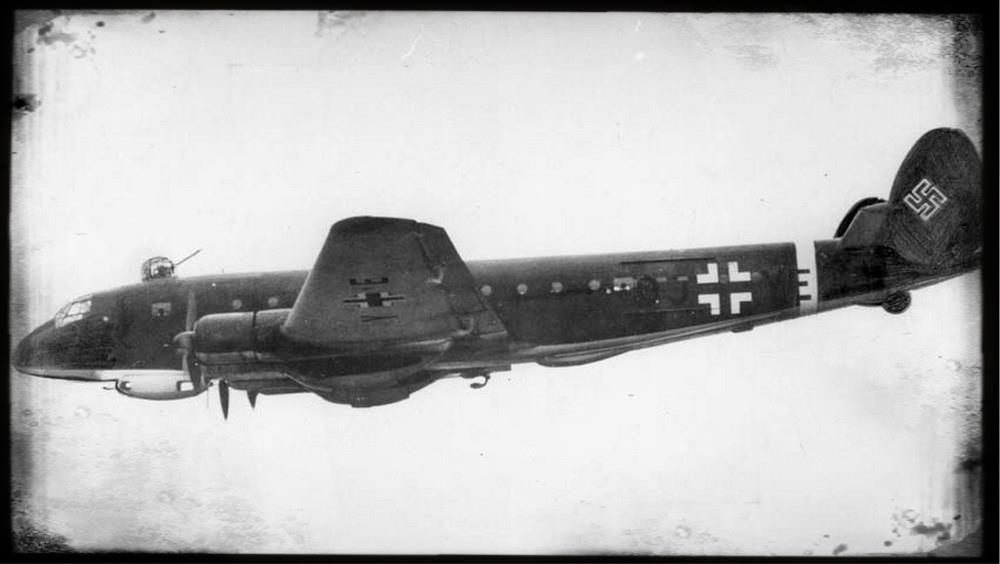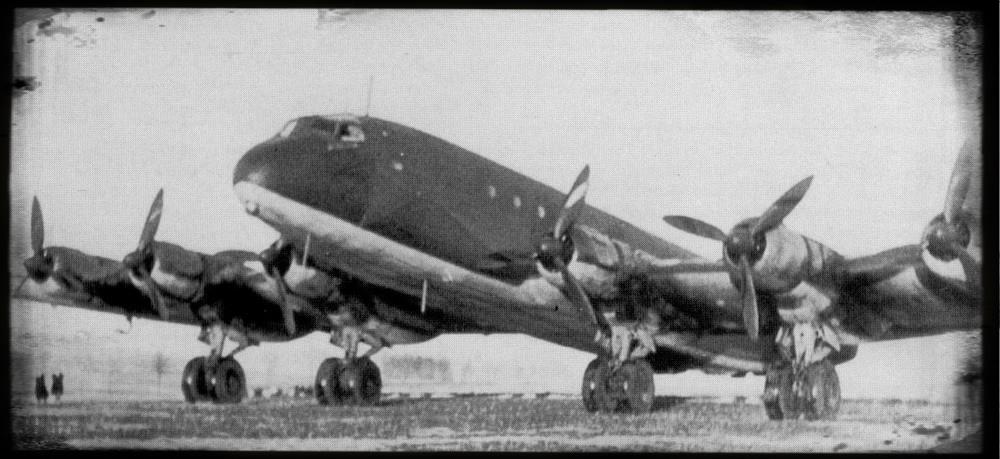Junkers Ju90
see also: Junkers Ju90 Production List / Junkers Ju90 Survivor List / Junkers Ju90 Philatelic Items / Junkers Ju90 Model Kits
passenger airliner, Transport and reconaissance aircraft, F/F: 28. August 1937
cantilever monoplane in smooth metal construction by Ernst Zindel and Wagner

Junkers Ju90-V1
Passenger Airliner Prototype
Historical Data:
During the developement of the Junkers Ju89, Lufthansa became interested in a similar aircraft for transport purposes. Already in 1935 Luftwaffe decided to offer the Ju89V3 to Lufthansa for test flights. Probably it was intended to use the Ju89V3 as a pure cargo aircraft at this time. But when the Ju89 programme was abandoned by Luftwaffe in April 1937, the Ju89V3 underwent major changes, which made it useable as a widebody passenger aircraft. Wings and tails were taken from the original Ju89 design, while the fuselage was a complete new construction and which was much brider than the original Ju89 fuselage. This new design was designated as Ju 90.
The Ju90V1, which was original the Ju89V3, was first flown on August 28th 1937 by Hesselbach. During the following flight tests, this prototype crashed on February 7th 1938 due to structural failure during overspeed. The second prototype was delivered to Lufthansa in May 1938 for operational test flights. This second prototype also crashed on November 21st 1938 during tropical flight tests at Bathurst due to an engine failure during take off.
In November 1938 Lufthansa ordered three Junkers Ju90, a further Ju90 was ordered by RLM for flight tests. This aircraft was later also taken over by Lufthansa. South African Airways ordered a further two Junkers Ju90 with Twin Wasp engines. These two aircraft were not delivered until the breakout of WWII and both later went to Luftwaffe. Lufthansa finally ordered a total of 12 Junkers Ju90. Just six were delivered until September 1939. These aircraft were transfered to Luftwaffe together with further deliveries from Junkers. They were used during the occupation of Norway as transport aircraft. Some of them later returned to Lufthansa for a few months, but finally all Ju90s were taken over from Luftwaffe. 
Junkers Ju90-V7 / Ju90-S
Horizontal Bomber Prototype
In April 1939 the RLM asked Junkers for a further developement of the Ju90 for military transport purposes. The Ju90V5 and V6, also known as Ju90B were the prototypes of this military design. They got a new wing and a BMW139 engine instead of the older BMW132. Modifications were also made at the tail unit and the undercarriage. The V5 flew first on December 5th 1939. A special equipment of the Ju90V6 was a boarding ramp in the floor of the fuselage. This ramp could be used to load cars and larger cargo freight. A further two prototypes (V7, V8) were ordered by Luftwaffe. Again these prototypes were equipped with a modified wing with increased span. The V8 was also equipped with machine gun towers for self defense. Actually the Ju90V8 was introduced as the Ju90 bomber version, known as Ju90S. These two prototypes flew first in September 1941. Delays were caused due to intensive modifications of the original Ju90 design and probably due to problems with the developement of the Ju88 programme. Junkers got an additional RLM request for a further two prototypes (V9, V10), which seemed to be dropped at the beginning of WWII. 
Junkers Ju290-V2
In 1941 the RLM again asked for the continuation of the Ju90 transporter developement by a request for two further prototypes (V11, V12). Due to extensive differences between the V11 and the original Ju90, the complete programme was renamed into Ju 290. The Ju90V11 and Ju90V12 were redesignated as Ju290V1 and Ju290V2. The V1 was first flown on July 16th 1942 by Pancherz. Major parts of the developement were performed at the Czech aircraft company Letov at Prague. It was also intended to set up a production line at Prague, but finally just components were produced at Letov. A total of six Ju290 military transporters were built as Ju290-A1 (including the V2 prototype). In May 1943 the first Ju290-A2 was first flown. The A2 to A7 were the surveyer version of the Ju290, which was used for aerial flights throughout the Atlantic Ocean. 
Junkers Ju290-A7 Recconaissance/Bomber Aircraft
While the Junkers Ju290-A1 to -A5 were very similar in their shape, the Junkers Ju290-A7 got a complete new front nose and a slightly modified tail unit. The front section was equipped with a machine gun tower, which made the Ju290-A7 not only usable as a pure reconnaissance aircraft, but also for ship target attacks. In May 1944 an improved Ju290-A7 was developed at Prague as Ju290-B, which should be suitable for higher altitudes and an increased take off weight of 49.500kg. The Ju290-B was capable for a payload of 4500kg of bombs or transport payload at a range of 5600km. At the end of WWII. The first Ju290B was still under construction at Letov in Prague. Further design studies for a Ju290-C and Ju290-D as a long range bomber with increased payload were under study, as well as a Ju290-E night bomber project. A total of 48 Junkers Ju290 were built until the end of WWII.

Junkers Ju290-Z Zwilling Aircraft
(c) Herwig/Rhode, taken from "Geheimprojekte der Luftwaffe"
In March 1942 the RLM was looking for highly improved long range aircraft, which could be used as bomber or surveyer. A Junkers project idea was the developement of a "Zwillings"-aircraft Ju290Z based on two Ju290. Like the Heinkel He111Z both aircraft were coupled by a common center wing, into which also four engines were integrated. For surveyer missions a Messerschmitt Me328 was placed on the top of one of the two Ju290 fuselages. The Ju290Z would have been a very quick developement for the RLM long range surveyer request as most of the components used by the Ju290Z were already available from the Ju290. The parallel design of the Junkers EF101 was a complete new developement and would have taken much more developement time. Nevertheless, both Mistel projects were finally abondend by the RLM.

Junkers Ju390V1 Prototype
Parallel to the Ju290Z a six engined Ju290 was under developement at Junkers since 1942. This developement was started under the designator Ju 390. On October 20th 1943 the Ju390 prototype was first flown by Pancherz at Merseburg.The flight tests were satisfying and RLM placed an order for 26 Ju390-A1 transporters in 1944. But in July 1944 all production activities were stopped for the increased fighter production. Only a second Ju390 aircraft was built until the end of the war. The Ju390 was intended as a widebody transporter Ju390A and long range surveyer aircraft Ju390B. Another purpose was a long range bomber aircraft Ju390C for missions to the United States (New York Bomber). It is reported that two aircraft flew from France to New York in 1944, but this seems to be wrong. The bomber version should have been able to pick up Henschel rocket bombs. Another Ju390 design saw a Mistel construction, where a Messerschmitt Me328 should have been put on the top of the Ju390. Probably at the beginning of the development of the Ju390, Lufthansa seemed to be interested in this design as well for long range air traffic after the war.

Junkers / Letov Ju290 Orel
Japan was also interested in the Ju390. An agreement was signed for a license production of the Ju390 in Japan in January 1945, but the shipping of the Ju390 documentation to Japan was not possible until the end of WWII.
The total Ju290 production came to an end in July 1944 with the start of the socalled "Jager-Notprogramm". But a single Ju290 was completed after WWII at Letov in Prague after WWII. This Ju290 was finished from parts produced for the first Ju290B. Letov redesigned this aircraft as a passenger aircraft under the designator Letov L.290 Orel. This aircraft flew first during 1946 and was used for flight tests. But it was never used in airline operations. In 1950 it was retired, probably as the last Ju290 and later it was scrapped.
Technical Data:
| Aircraft | year | engine | length in m | span in m | wing area im sqm | net weight in kg | payload in kg | seats | speed in km/h | range in km |
|---|---|---|---|---|---|---|---|---|---|---|
| Ju90V3 | 1937 | 4 x BMW132H1 (610kW) | 26,45 | 35,30 | 184,00 | 16500 | 6800 | 3 | 350 | 1050 |
*) series A9 with BMW801G
- Airwar.ru - Ju90 Story, Data, Photos
Airwar.ru - Ju290 Story, Data, Photos
Airwar.ru - Ju390 Story, Data, Photos - Flugzeug-Lorenz.de - Ju90 Extract from Lorenz book "Kennzeichen Junkers"
- Wikipedia.org - Ju90 Story, Data, Photos
Wikipedia.org - Ju290
Wikipedia.org - Ju390 - Youtube.com - German Ju90 Video
- ww2transportaircrafts. - Ju90 individual aircraft history
- WarbirdsResourceGroup.org - Ju290 Story, Data, Photos
- bell.GreyFalcon.us - Ju390 New York Flight Speculations
GreyFalcon.us - Mistel Operations
Literature:
- H.J. Nowarra
Junkers Ju290, Ju390
Schiffer Publishing, 1997, ISBN 764302973 - H. Bukowski, F. Mueller
Junkers Ju90 - Ein Dessauer Riese
Brandenburgisches Verlagshaus, 1995, ISBN 3-89488-083-X - Karl Koessler, Günther Ott
Die grossen Dessauer: Ju89, Ju90, Ju290, Ju390
Aviatik Verlag, 1993, ISBN 3-925505-25-3 - H.J. Nowarra
Junkes Grossflugzeuge
Motorbuch Verlag, 1988, ISBN 3-613-01224-3, - Thomas Hitchcock
Junkers Ju290
Monogram Aviation, 1975, ISBN 914144030 - K.H. Regnat
Vom Original zum Modell: Junkers Ju290/390
Bernard + Graefe Verlag, 2003, ISBN 3-7637-6033-4
introduced Jul 1996, transfered Aug 2017
http://hugojunkers.bplaced.net/
contents last updated 5 Jul 2003

